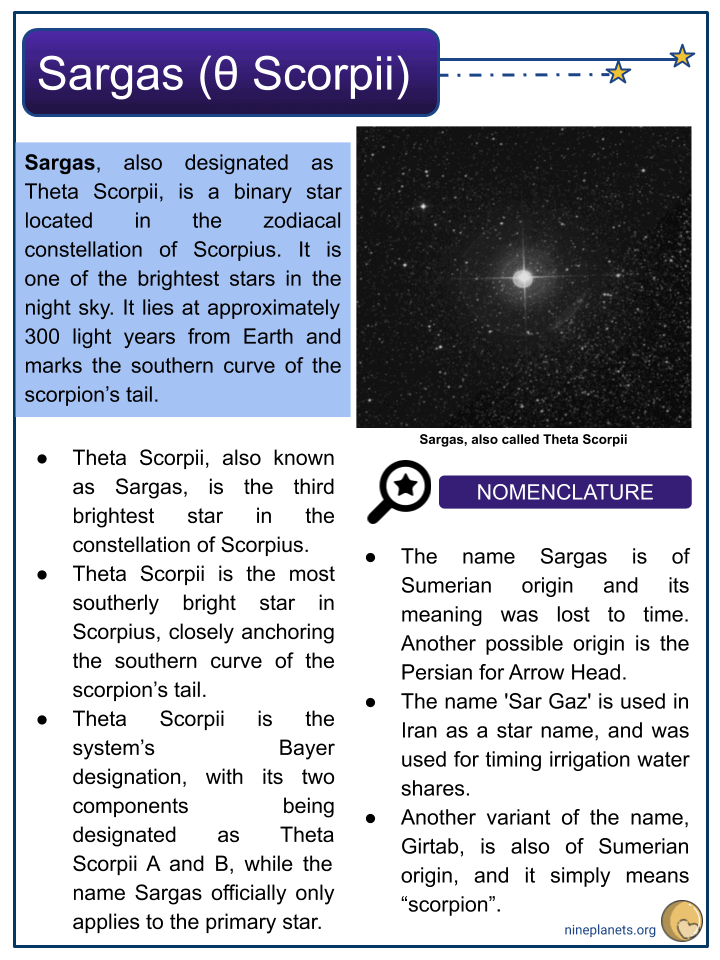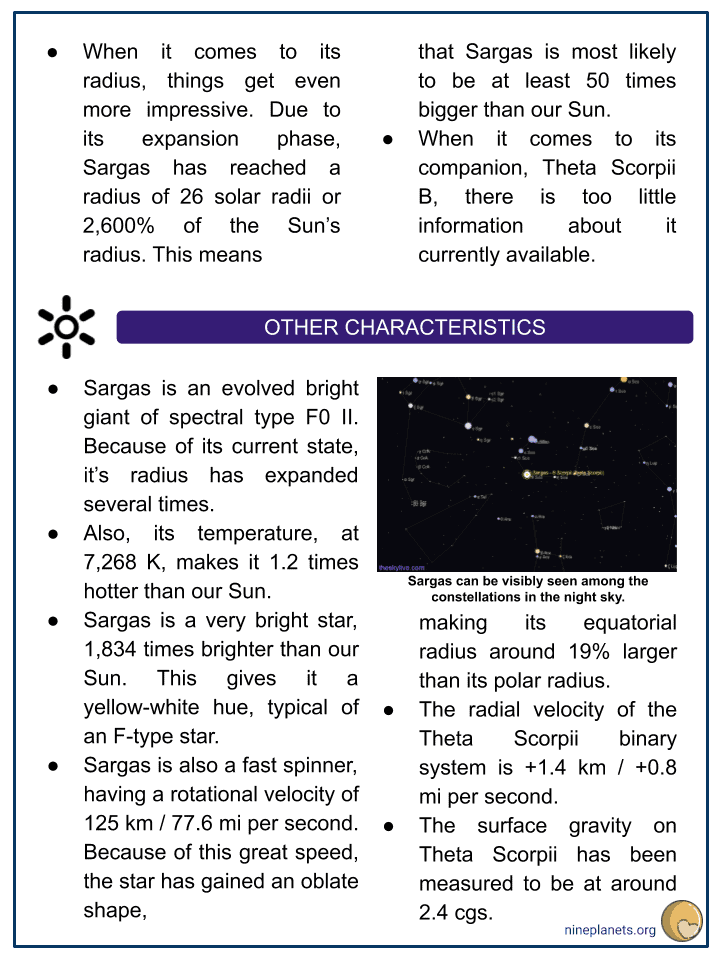Download Sargas (θ Scorpii) Worksheets
Click the button below to get instant access to these premium worksheets for use in the classroom or at a home.

This worksheet can be edited by Premium members using the free Google Slides online software. Click the Edit button above to get started.
Download free sample
Not ready to purchase a subscription yet? Click here to download a FREE sample of this worksheet pack.
Resource Examples
Click any of the example images below to view a larger version.




Key Facts & Information
- Sargas, also designated as Theta Scorpii, is a binary star located in the zodiacal constellation of Scorpius. It is one of the brightest stars in the night sky. It lies at approximately 300 light years from Earth and marks the southern curve of the scorpion’s tail.
- Theta Scorpii, also known as Sargas, is the third brightest star in the constellation of Scorpius.
- Theta Scorpii is the most southerly bright star in Scorpius, closely anchoring the southern curve of the scorpion’s tail.
- Theta Scorpii is the system’s Bayer designation, with its two components being designated as Theta Scorpii A and B, while the name Sargas officially only applies to the primary star.
Nomenclature
- The name Sargas is of Sumerian origin and its meaning was lost to time. Another possible origin is the Persian for Arrow Head.
- The name ‘Sar Gaz’ is used in Iran as a star name, and was used for timing irrigation water shares.
- Another variant of the name, Girtab, is also of Sumerian origin, and it simply means “scorpion”.
- In 2016, the WGSN approved the name Sargas for the star θ Scorpii A on 21 August and it is now also included in the List of IAU-approved Star Names.
- The Chinese know Sargas / Theta Scorpii as Wei Xiu wu – the Fifth Star of Tail – referring to a part of the Tail mansion, and representing the tail of the Azure Dragon.
- It is formed by Sargas with Xamidimura (Mu Scorpii), Larawag (Epsilon Scorpii), Zeta Scorpii, Eta Scorpii, Iota Scorpii, Kappa Scorpii, Shaula (Lambda Scorpii), and Lesath (Upsilon Scorpii).
Formation
- Sargas’s exact age is currently unknown. However, we do know that the star is an evolved bright giant. Sargas formed from an interstellar medium of dust and gas.
- Gravity pulled the swirling gas and dust together and resulted in the third brightest star of Scorpius, that we today now see.
Distance, Size And Mass
- Sargas is situated at around 300 light years / 90 parsecs away from Earth. It is among the brightest stars in the night sky, easily visible with the naked eye.
- Sargas’s mass is around 5.66, which means it is 566% more massive than our Sun.
- When it comes to its radius, things get even more impressive. Due to its expansion phase, Sargas has reached a radius of 26 solar radii or 2,600% of the Sun’s radius. This means that Sargas is most likely to be at least 50 times bigger than our Sun.
- When it comes to its companion, Theta Scorpii B, there is too little information about it currently available.
Other Characteristics
- Sargas is an evolved bright giant of spectral type F0 II. Because of its current state, it’s radius has expanded several times.
- Also, its temperature, at 7,268 K, makes it 1.2 times hotter than our Sun.
- Sargas is a very bright star, 1,834 times brighter than our Sun. This gives it a yellow-white hue, typical of an F-type star.
- Sargas is also a fast spinner, having a rotational velocity of 125 km / 77.6 mi per second. Because of this great speed, the star has gained an oblate shape, making its equatorial radius around 19% larger than its polar radius.
- The radial velocity of the Theta Scorpii binary system is +1.4 km / +0.8 mi per second.
- The surface gravity on Theta Scorpii has been measured to be at around 2.4 cgs.
- Theta Scorpii’s absolute magnitude is estimated to be at -2.71.
- Some sources state that Sargas is a variable star, while others believe that it will become a variable star of the Cepheid type, in around a million years.
- Sargas has a fairly long rotation, given its size, completing one rotation in 10 days or so.
- Theta Scorpii / Sargas – is the 39th brightest star in the night sky and can be observed with the naked eye.
Stellar System
- Not much is currently known about the Theta Scorpii star system except that it is a binary star system in the southern zodiac constellation of Scorpius.
- The two components, Theta Scorpii A (Sargas), and Theta Scorpii B, are situated at an angular separation of 6,470 arcseconds.
- The primary star has an apparent magnitude of 1.87 and its companion a magnitude of 5.36.
Location
- Sargas / Theta Scorpii is situated in the zodiacal constellation of Scorpius. It is the third brightest star in the constellation.
- This constellation is situated in the southern celestial hemisphere.
- The constellation of Scorpius is among the 48 constellations depicted by the Greek astronomer Ptolemy, in his 2nd-century book Almagest.
- It is an ancient constellation that pre-dated the Greeks, and it lies between Libra to the west and Sagittarius to the east.
- The constellation represents the scorpion that stung Orion, the hunter in Greek mythology.
- Scorpius is the 33rd constellation in size, occupying an area of 497 square degrees.
- It lies in the third quadrant of the southern hemisphere and is best seen at latitudes between +40 and -90 degrees.
- Sargas is the most southerly bright star in the constellation, closely anchoring the southern curve of the celestial scorpion’s tail. Scorpius is filled with bright blue-white stars of class B.
- Sargas can be found using two bright asterisms in the vicinity: the Teapot, formed by the brightest stars of Sagittarius, and the Fish Hook, formed by the Scorpius stars Antares, Acrab, Dschubba and Fang.
- A line from Nunki, the top left star of the Teapot, through Kaus Australis, the bottom right star, leads towards Sargas.
- Alternatively, a line extended from Acrab, the top right star of the Fish Hook, through Antares, the brightest star in Scorpius, also points in the direction of Sargas.
- The best time of year to observe the stars and deep sky objects of Scorpius is during the month of July, when the constellation is prominent in the evening sky. This constellation is easy to find since it is located near the centre of the Milky Way.
- It contains several notable stars and deep sky objects such as: Antares, Shaula, the Butterfly Cluster, the Ptolemy Cluster, Cat’s Paw Nebula, the War and Peace nebula, and more.
- The 10 brightest stars in Scorpius:
- Antares (Alpha Sco A, mag. 0.6-1.6)
- Shaula (Lambda Sco A, mag. 1.62)
- Sargas (Theta Sco A, mag. 1.84)
- Dschubba (Delta Sco, mag 2.307)
- Larawag (Epsilon Sco, mag. 2.31)
- Kappa Sco (mag. 2.39)
- Acrab (Beta Sco, mag. 2.62)
- Lesath (Upsilon Sco, mag. 2.70)
- Paikauhale (Tau Sco, mag. 2.82)
- Fang (Pi Sco, mag. 2.89)
The Future
- Sargas stands out in its constellation filled with bright blue-white stars of class B. The star is rapidly evolving with a dead helium core towards lower temperatures.
- Around one hundred million years ago, Sargas was also a B star like its current numerous neighbours.
- As the star swells and its surface cools, it should, in under a million years, become a Cepheid variable type of star.
- It will then become a red giant five times brighter than it is now, at which point the helium in its core will begin to fuse carbon and oxygen, setting the stage for it to become a massive white dwarf.
Did You Know?
- Sargas appears on the flag of Brazil, symbolising the state of Alagoas.
- Sargas is moving farther away from the Sun at a speed of 1 kilometre per second.
- Sargas is situated in the south of the celestial equator, thus it is more visible from the southern hemisphere.
- Some believe that Sargas will become a Cepheid variable very similar to Mekbuda/Zeta Geminorum.
- Cepheid variable
- a yellow giant or supergiant pulsating variable whose period of pulsation is directly related to its luminosity: the longer the period, the greater its brightness.